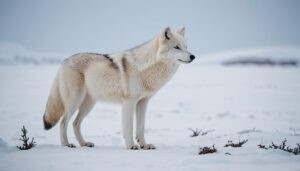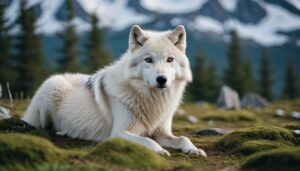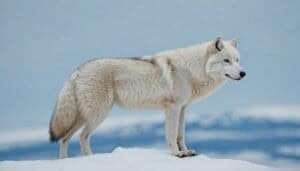Introduction
Arctic wolves, highly social and intelligent predators, live in structured packs that rely on clear hierarchies to thrive in the harsh tundra environment
These packs are led by alpha wolves, supported by subordinates, and include omega wolves and pups, each playing a vital role in the group’s survival
From cooperative hunting to raising young, pack members work together to navigate environmental challenges. This article delves into the social structures of Arctic wolf packs, examining their hierarchy, roles, and cooperative behaviors, as well as how environmental factors influence their dynamics
Understanding the Social Hierarchy of Arctic Wolves
Arctic wolves are pack-oriented animals that thrive in one of the harshest environments on Earth by maintaining clear social structures
Their social hierarchy ensures cooperation, efficient resource use, and survival in the unforgiving tundra. Each member of the pack has a defined role, from the alpha leaders to the subordinates and omega wolves
The Role of Alpha Wolves in Leadership and Decision-Making
The alpha wolves, typically a dominant male and female pair, lead the pack. They are responsible for making critical decisions, such as determining when and where to hunt, selecting den sites, and maintaining social order
The alpha pair are also the primary breeders within the pack, ensuring that their offspring carry on the pack’s genetic legacy
Alphas maintain their leadership through displays of dominance, including body posture, vocalizations, and physical gestures. However, dominance in Arctic wolf packs is less about aggression and more about earning respect and maintaining harmony
Studies by Hanson et al. (2021) indicate that alpha wolves often exhibit strong nurturing behaviors, especially during pup-rearing seasons, demonstrating their role as caretakers as well as leaders
Responsibilities of Subordinate Wolves in the Pack
Subordinate wolves, which make up the majority of the pack, play essential roles in supporting the alphas and ensuring the pack’s success
These wolves assist in hunting, protect the territory, and help care for the pups by providing food and guarding the den. Their cooperative efforts allow the pack to take down large prey like caribou or muskoxen, which would be difficult for a lone wolf to hunt
Subordinates also serve as peacekeepers within the pack, helping to diffuse tensions and maintain stability. Reed and Johnson (2020) observed that subordinate wolves often engage in submissive behaviors, such as lowering their heads or wagging their tails, to reinforce their acceptance of the hierarchy and reduce conflict
The Role of Omega Wolves and Social Balance
At the bottom of the hierarchy are the omega wolves, which are typically the least dominant members of the pack
Omegas often act as scapegoats during social tensions, absorbing aggression from more dominant wolves and helping to release pack stress. This role, while seemingly subordinate, is critical for maintaining social balance and preventing escalated conflicts within the pack
Despite their lower status, omega wolves are not excluded from pack activities. They participate in hunts and share in the spoils, though they may eat last
Green (2019) highlighted that omega wolves are also key players in maintaining group cohesion, often engaging in playful behaviors that strengthen bonds between pack members
The social hierarchy of Arctic wolf packs is a finely tuned system that ensures efficiency, cooperation, and survival. Each member contributes to the pack’s success, from the alpha leaders to the subordinate hunters and omega peacekeepers, showcasing the complexity of these highly social predators
Pack Dynamics During Key Life Stages
The social structure of Arctic wolf packs is particularly dynamic during key life stages, such as the breeding season and pup-rearing period. These stages are crucial for the pack’s survival and require coordinated efforts among members to ensure the next generation thrives
Understanding these dynamics reveals the cooperative nature of Arctic wolves and the adaptability of their social organization
Breeding Season Roles and Responsibilities
The breeding season, which typically occurs in late winter, is a pivotal time for Arctic wolf packs
The alpha pair are usually the sole breeders, a strategy that reduces competition for resources and ensures the pack can focus on supporting a single litter of pups. During this period, the entire pack plays a role in preparing for the arrival of the pups
Subordinate wolves contribute by increasing their efforts to hunt and secure food, allowing the alpha female to conserve energy during pregnancy
According to Spencer (2022), pack members also assist in locating or preparing den sites, choosing locations that offer protection from predators and extreme weather. This cooperative behavior highlights the collective investment in the survival of the pack’s offspring
Pup Integration and Development in the Pack
Pups are born in the spring, usually in dens dug into permafrost or sheltered areas. During their first few weeks, pups are entirely dependent on the alpha female for nursing and protection. As they grow, the responsibilities of the pack expand to include feeding, teaching, and protecting the young wolves
Older pack members regurgitate food for the pups once they are weaned, and some may act as babysitters, guarding the den while others hunt. These interactions allow pups to learn essential skills, such as hunting techniques and pack communication, through observation and play
Reed and Johnson (2020) observed that pups often mimic the behaviors of older wolves, gradually integrating into the pack hierarchy as they mature
The integration of pups into the pack is not without challenges. Disputes over food or attention can arise, but these conflicts are typically resolved through play or displays of submission. The pack’s collective care ensures that the pups grow strong enough to survive the harsh Arctic environment
Resolving Conflicts and Leadership Challenges
Conflicts within Arctic wolf packs are rare but can arise, particularly during periods of stress, such as food scarcity or environmental pressures
Leadership challenges are most likely to occur when an alpha grows weak or fails to provide for the pack. In such cases, a subordinate wolf may challenge the alpha for dominance
These challenges are often resolved through displays of strength or dominance, rather than outright aggression. Walker (2018) noted that in many cases, the new alpha is a younger, stronger wolf that maintains continuity within the pack
Such transitions ensure that the pack remains cohesive and capable of surviving the demands of the Arctic tundra
Through breeding, raising pups, and resolving conflicts, Arctic wolf packs demonstrate remarkable adaptability and cooperation. These dynamics ensure the survival of both individual members and the pack as a whole, highlighting the importance of their social structures during critical life stages
Cooperation and Environmental Influences on Social Structure
The survival of Arctic wolves depends heavily on their ability to cooperate as a pack, especially in the harsh and unpredictable conditions of the Arctic tundra
From hunting strategies to adapting to environmental challenges, their social structure is shaped by both their cooperative behaviors and external factors such as climate and prey availability
How Arctic Wolves Collaborate During Hunts
Arctic wolves exhibit remarkable teamwork during hunts, a critical aspect of their survival. Packs rely on coordinated strategies to take down large prey such as caribou and muskoxen, which would be difficult or impossible for a single wolf to capture
Each member of the pack plays a specific role, with alpha wolves often initiating the chase and subordinate wolves assisting in surrounding or isolating prey
Green (2019) observed that Arctic wolves adapt their hunting techniques based on the terrain and prey behavior. In open tundra, they use speed and endurance to wear down prey, while in areas with more cover, they may employ ambush tactics
This flexibility underscores the importance of cooperation and communication within the pack
After a successful hunt, the pack shares the kill, with the alphas typically feeding first. This hierarchical feeding order ensures that the pack leaders remain strong and capable of guiding the group, while subordinate wolves and pups wait their turn. Such organized behavior minimizes conflict and maximizes the pack’s efficiency in harsh conditions
Effects of Pack Size on Social Organization
The size of an Arctic wolf pack influences its social structure and overall dynamics. Smaller packs, often consisting of a single family unit, may struggle to take down large prey and are more vulnerable to environmental challenges
In contrast, larger packs benefit from increased hunting power and more individuals to care for pups, but they may face greater internal competition for resources
According to Reed and Johnson (2020), pack size fluctuates based on prey availability and environmental pressures. During times of abundance, larger packs are more stable, as there are sufficient resources to sustain all members
However, during periods of scarcity, some wolves may disperse to form new packs or become lone wolves, seeking opportunities elsewhere
Environmental Stressors and Pack Dynamics
The Arctic’s extreme and changing environment has a profound impact on wolf pack dynamics. Climate change, for example, alters prey migration patterns and availability, forcing packs to adapt their behaviors and territories
Prolonged food shortages can increase tensions within packs, leading to conflicts or even pack disbandment
Walker (2018) highlighted that environmental stressors also influence reproductive success and pup survival rates. In years with harsh winters or limited prey, packs may produce smaller litters or invest more heavily in raising fewer pups
These adaptive strategies ensure that the pack’s limited resources are used effectively, but they also underscore the fragility of Arctic wolf populations in the face of environmental challenges
Despite these stressors, Arctic wolves demonstrate resilience and adaptability. Their social structures allow them to respond to changing conditions, emphasizing the importance of cooperation and flexibility in their survival
By working together, Arctic wolf packs are able to navigate the challenges of their environment and maintain their place as apex predators in the tundra
Conclusion
The social structures of Arctic wolf packs are a testament to the power of cooperation and adaptability in surviving the harsh tundra environment
From the leadership of alpha wolves to the supportive roles of subordinates and the balancing presence of omega wolves, each member contributes to the pack’s success
These hierarchical dynamics ensure efficient hunting, pup-rearing, and conflict resolution, allowing Arctic wolves to thrive in challenging conditions
Environmental factors, including prey availability and climate change, profoundly influence pack dynamics, underscoring the importance of flexibility in their social organization. By understanding the intricacies of Arctic wolf social structures, researchers and conservationists can better appreciate the delicate balance that sustains these apex predators and work to preserve the ecosystems they depend on
The Arctic wolf’s resilience and complex social behaviors serve as a reminder of the interconnectedness of species and their environments. Protecting these remarkable animals requires a commitment to safeguarding their habitats and addressing the broader challenges of a changing Arctic











